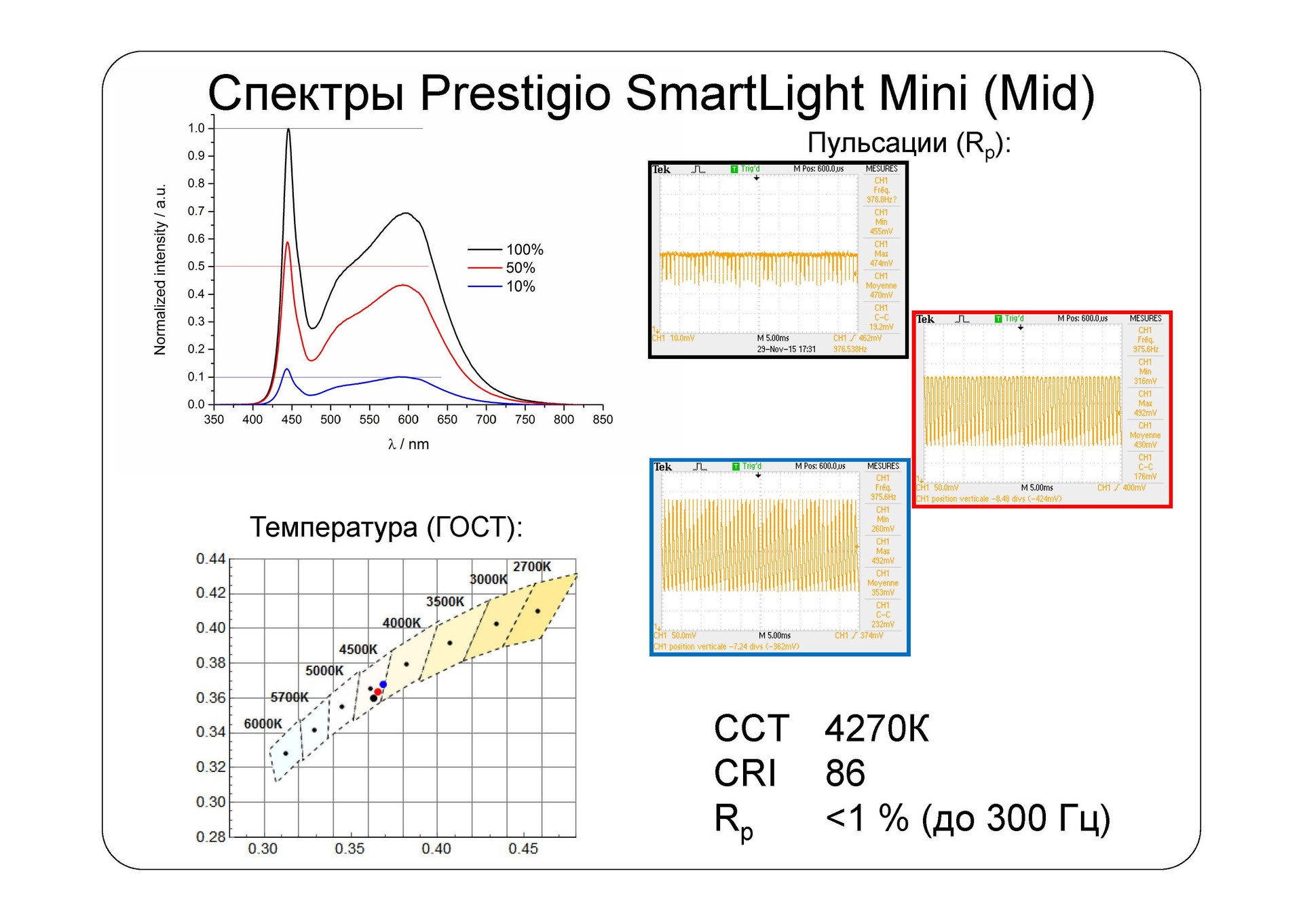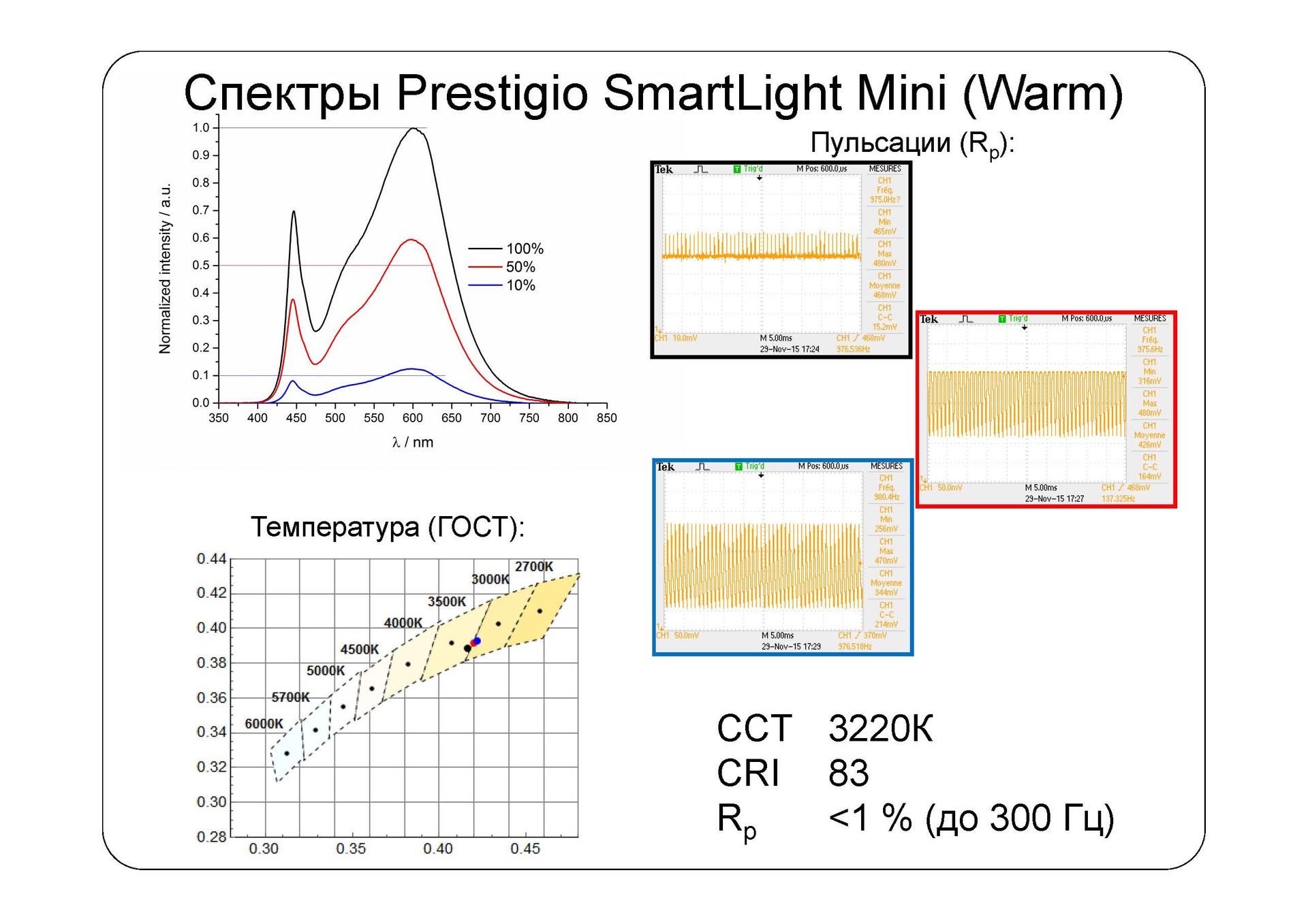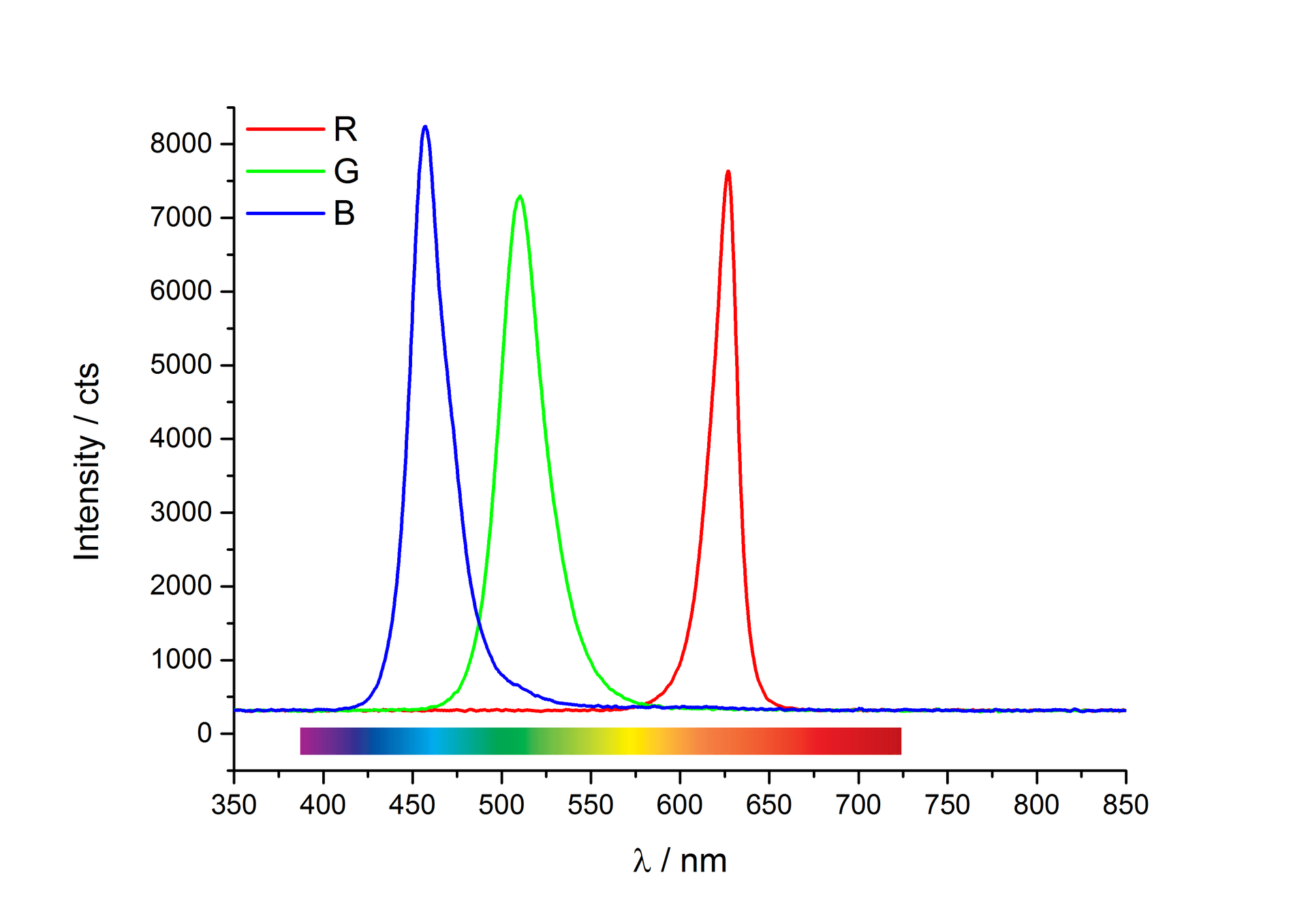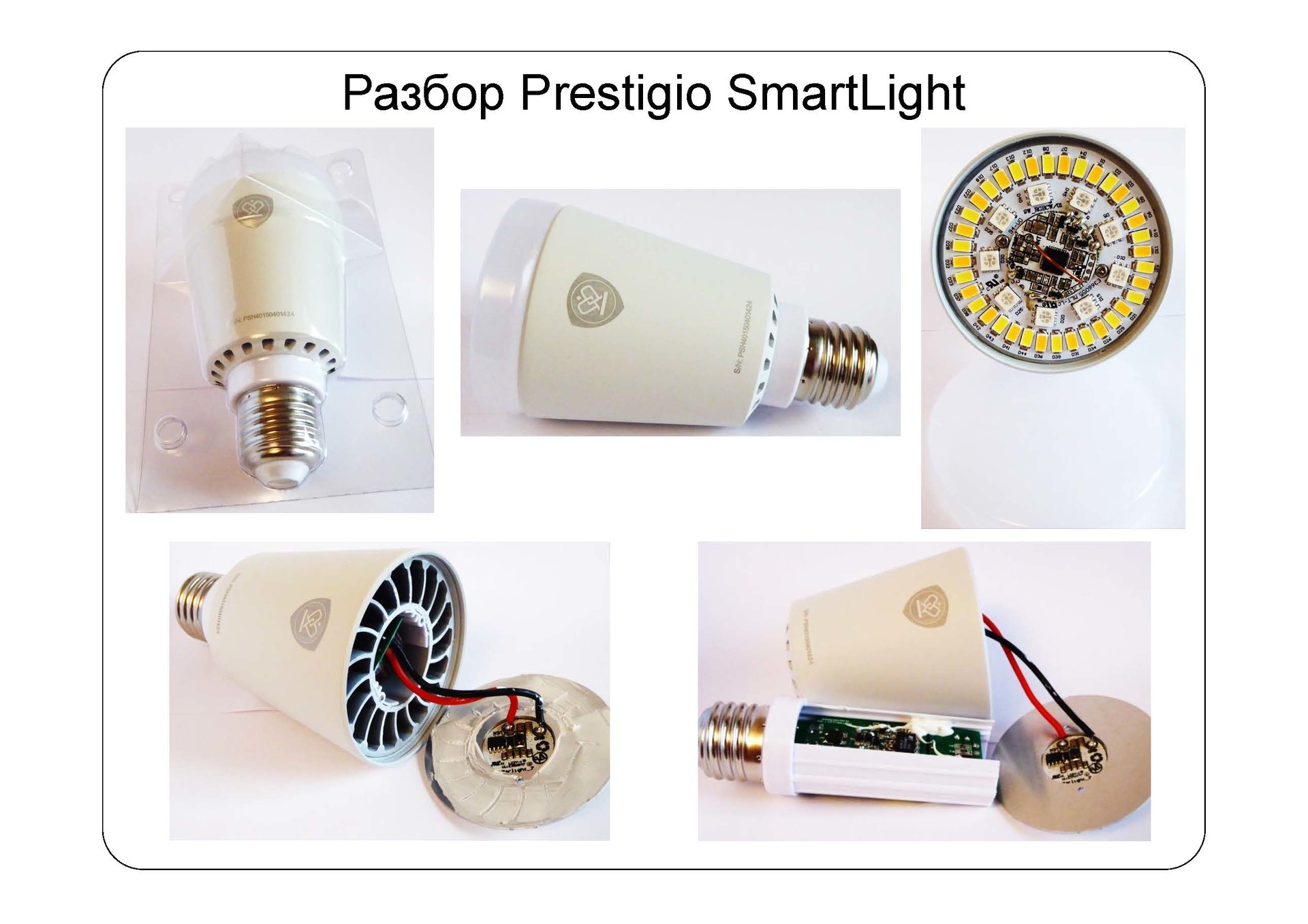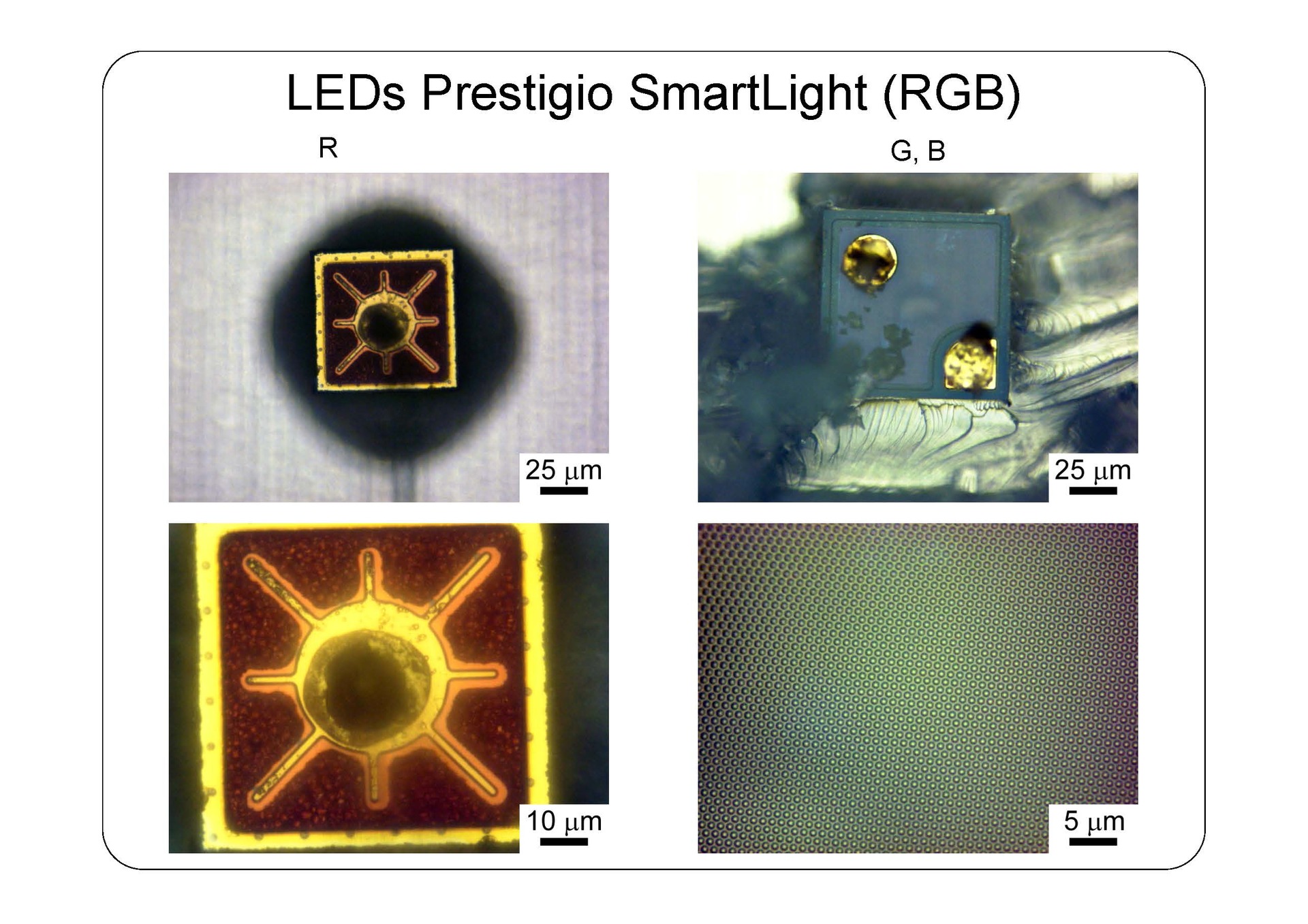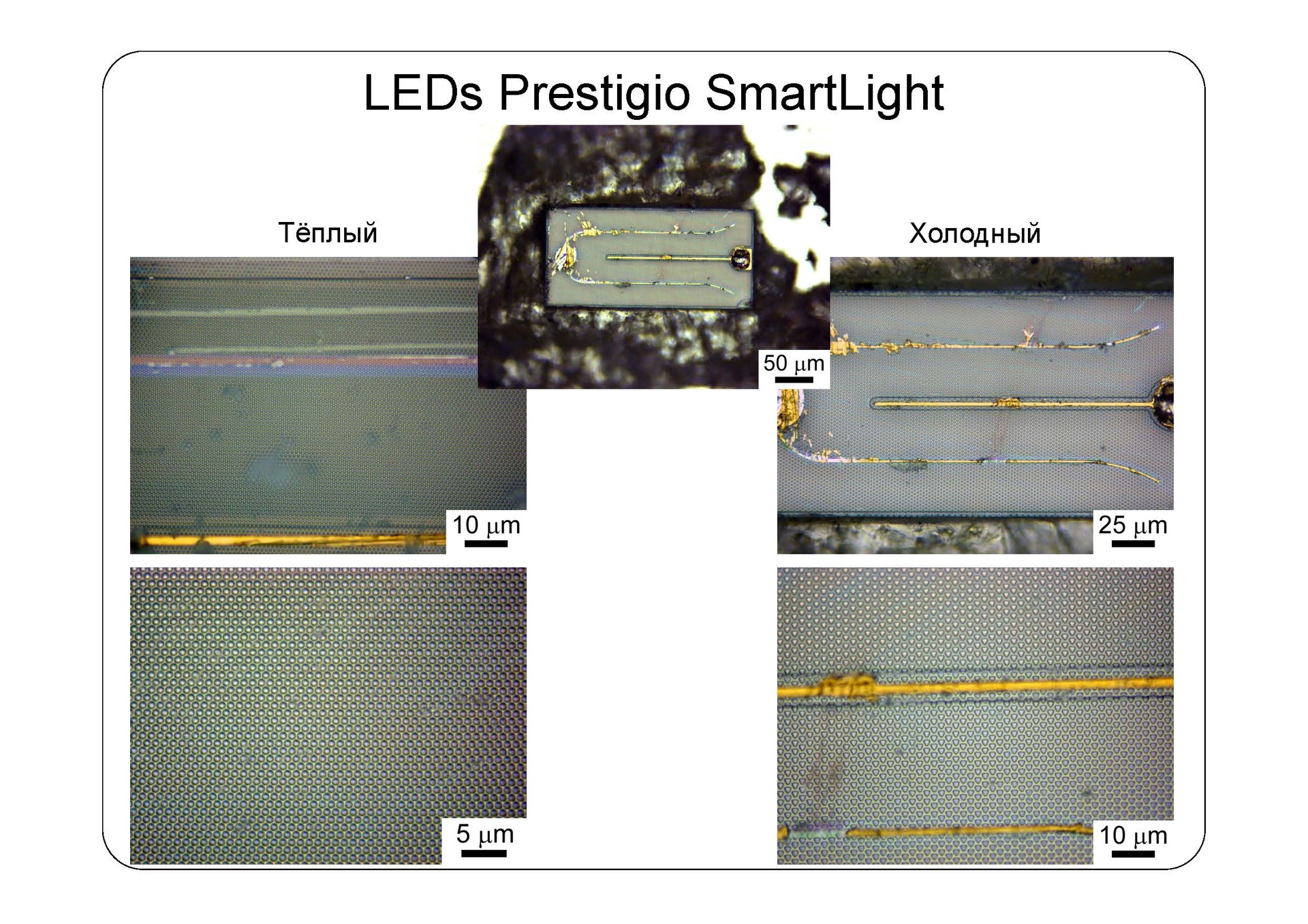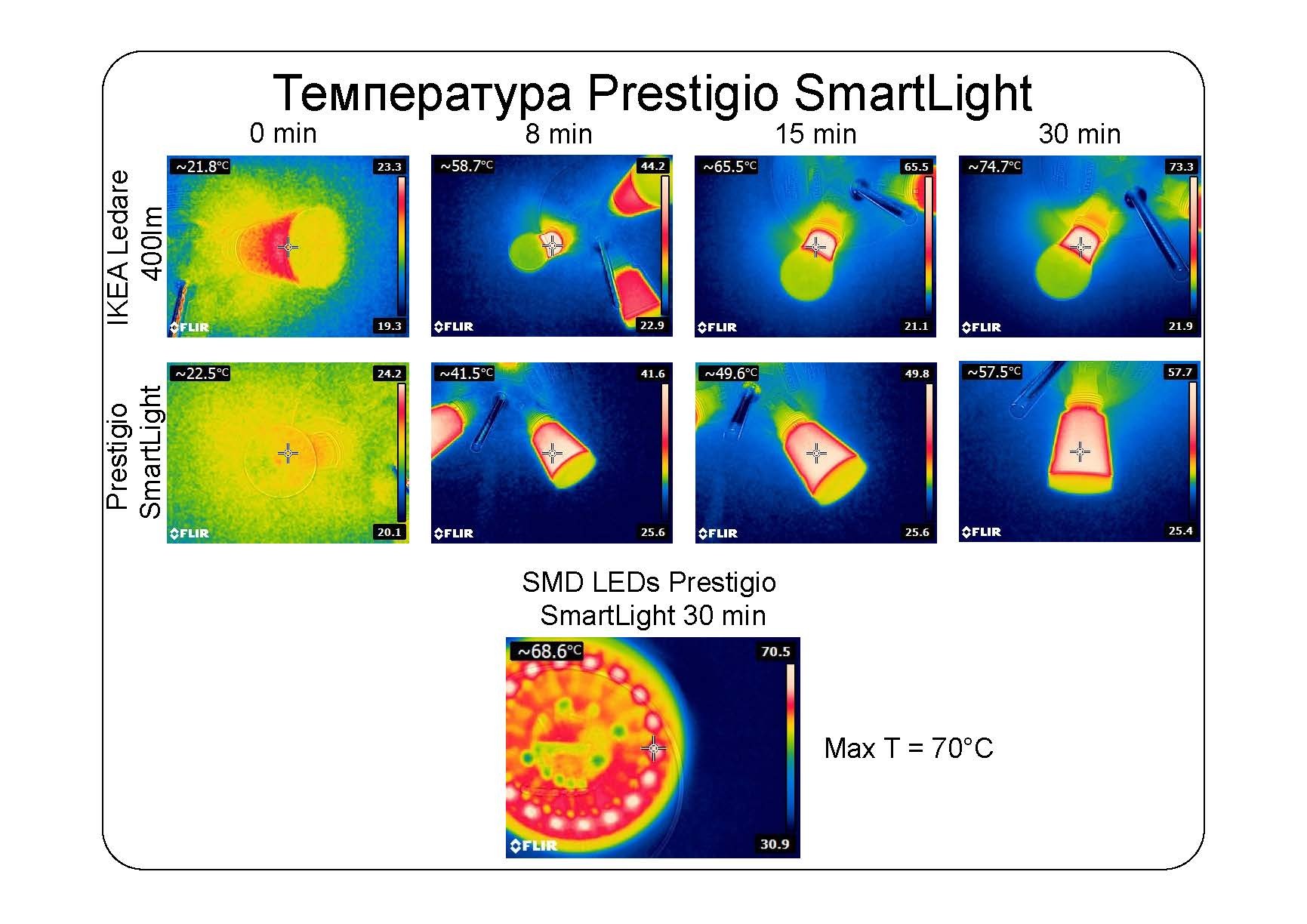An inside look: smart lights SmartLight (UPD)
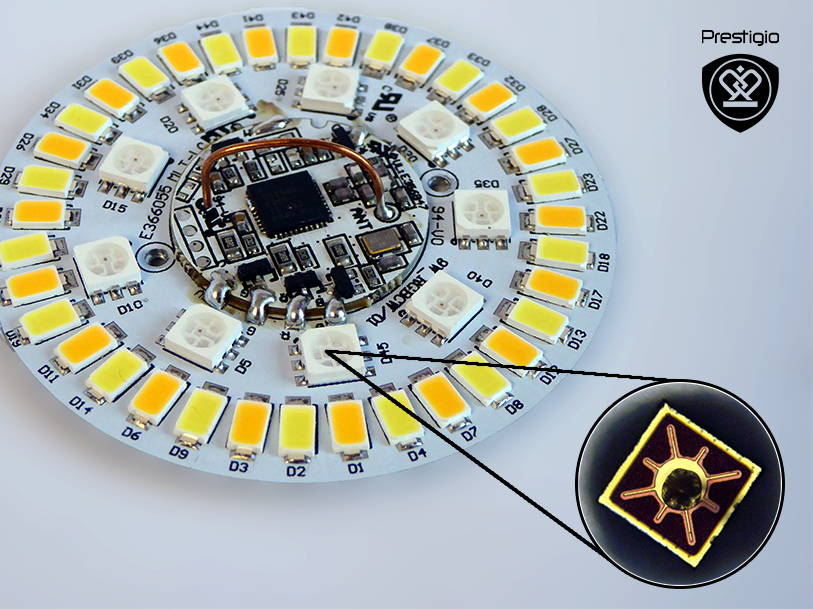
We welcome fans of LED-lamps on the pages of the blog Prestigio!
Optimistic forecasts of analysts of the IoT world predict the intensive entry of smart things into our everyday life. In order not to stay away from global trends, as promised in the previous article , today we will talk about smart lights SmartLight from the company Prestigio. And even look inside one of them. So sit back - we start!
Introductory part
At the moment , Prestigio’s arsenal has two lines of smart lamps. The first group is LED lamps that can change both the brightness of the lighting over a wide range (up to 1%), the color temperature (from 3000 to 6000K) and even the color itself (from red to blue). On sale are models in the most common versions of caps: GU10 , E14 / E27 at 5W , as well as E27 at 7W and E27 at 9 W. The second group is the simpler versions of the above 7-watt E27 lamps — only with a dimming function ( warm 3000K and cold 5000K lights are available).
All lamps are controlled through the Prestigio Smart Home app, which is currently available only for the Android platform, but we are also working on an iOS version.
')
Since we have touched on the subject of the application, let's deal with it first.
Prestigio Smart Home: command the lamps and not only
Prestigio Smart Home has an intuitive interface, made in the now traditional Materials Design style from Google. At the start, it will offer to turn on the BlueTooth module of the smartphone or tablet and scan for the presence of lamps in sight (the lamp, of course, must be included in the network).

Three main screens to set up Prestigio's smart lamp
Then the user enters the screen with a full list of available devices (lamps, weather station and / or multi-center). Using the pencil icon, you can group and organize the found BT devices. At the same time, lamp control is carried out both as a single group and separately. Tap on the lamp icon leads to the third screen, where the color temperature or color, as well as the light intensity, are adjusted.
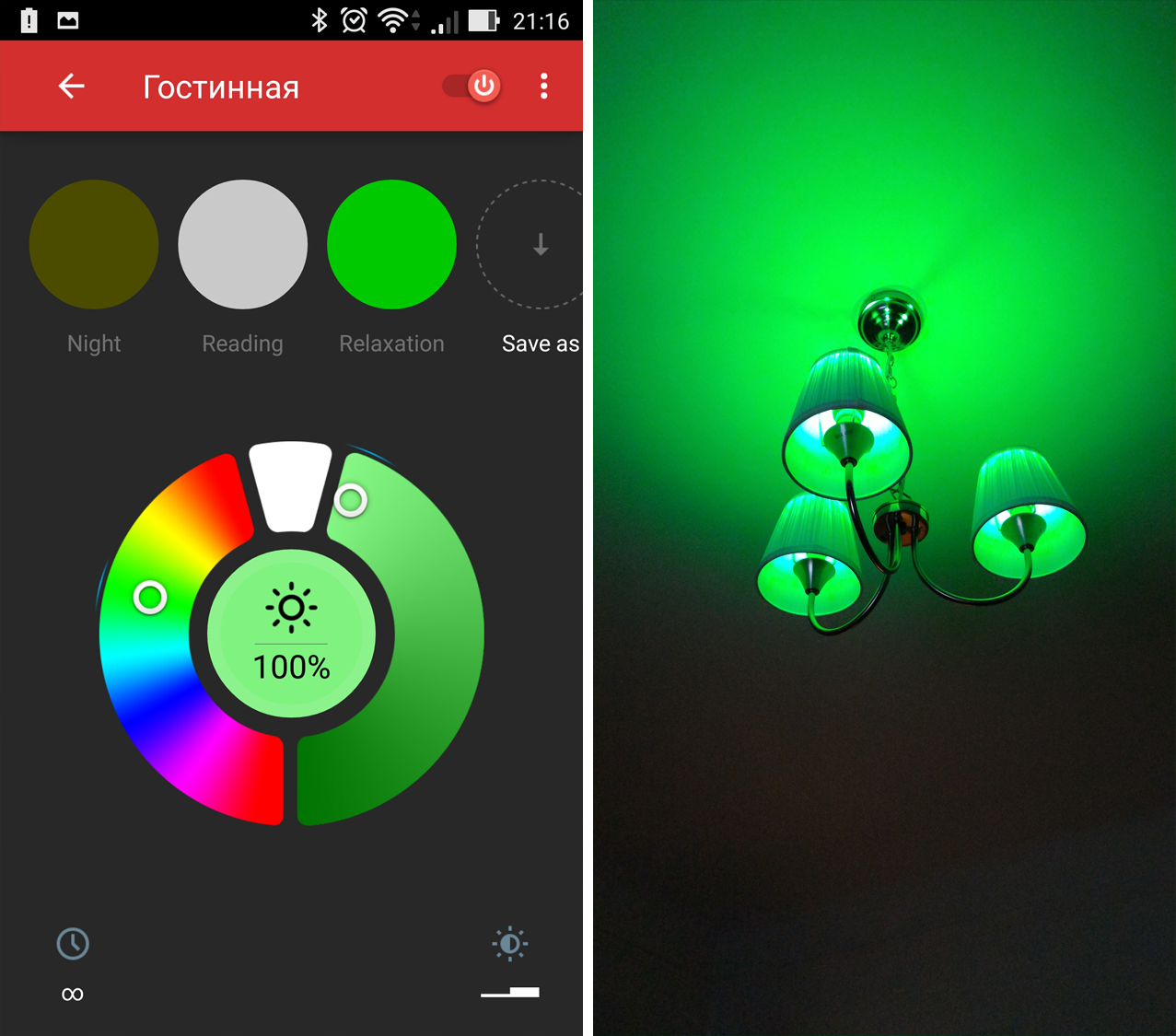
In the application, you can also create your own presets for colors, light intensity and color temperature, which is very convenient if you frequently change them and set up actions with lamps
The menu icon at the top right of the screen gives access to the list of actions with lamps. So, through the application, you can configure an action and / or notification to be performed once or according to a schedule. For example, turn the lamp on and off, set the light level, set the color temperature, or select the lamp color.

Plus, a feature such as Light Organ is built into the application - a special function that allows you to use the little ones (better, of course, several of them) as color music. The phone reads the surrounding musical chaos and chaos and translates it into the color and intensity of the flashing lamp, which vary in the music.
And if something went wrong, you can always reset the PIN code used to encrypt the BT protocol and reconnect the lamp.
On the Internet, there was even a video demonstrating the capabilities of the application and lamps:
We will return to the weather station Smart Weather Station in one of the following reviews.
SmartLight Mini E14 (5 W): small spool, yes roads
Let's go back to our light bulbs.
Let's start with the packaging. Each lamp comes in a box, where the LED-lamp is securely fixed and does not hang when transported using a plastic case. Inside the box there is a detailed instruction on how to use the lamp, which application to download and how to use it. The instruction is detailed, so even if you want to give a lamp to an elderly person (mom, dad, grandmother or grandfather) or even a “blonde”, then there should be no problems with connecting and setting, there would be an Android phone with Bluetooth function.

Reversal of the SmartLight Mini Box
Under the diffuser is a close-packed LEDs on an aluminum board with a BT module. They are of two types: those that are responsible for the temperature, and the RGB LEDs in the SMD package with a transparent fill. We will talk about them a bit later.
It should be noted that Prestigio uses proven and reliable components. For example, the control BT chip is CC2540 from Texas Instruments .
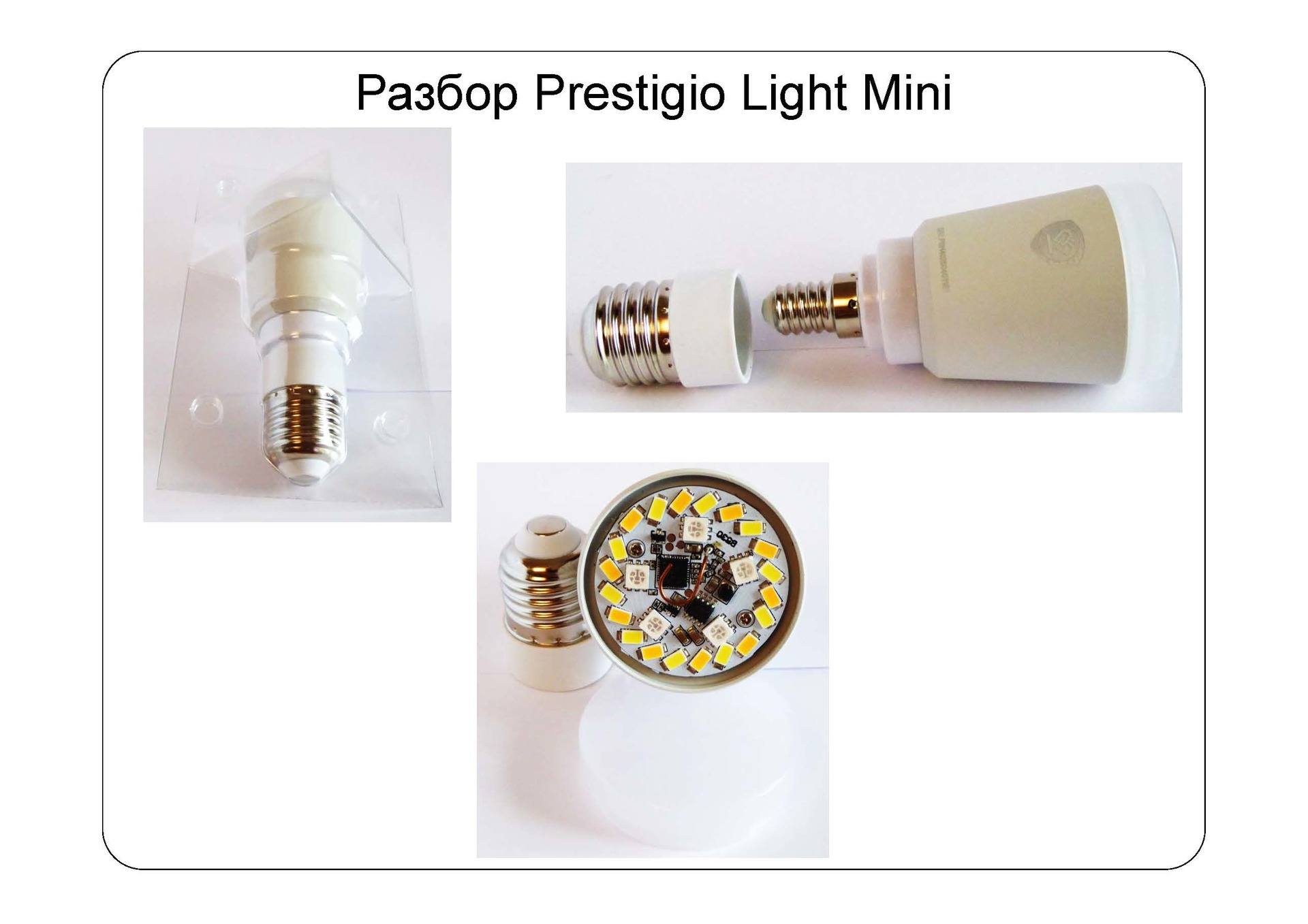
The transparent diodes are RGB LED assemblies, the yellow and orange diodes are responsible for the “warmth” and “cold” of the outgoing light. In the center perched BT antenna from copper wire
And according to the already good tradition of fights with LED lamps, the spectra obtained during testing are presented below. The lamps dim well, the minimum level that can be reached is 1%. Below are the spectra for three different color temperature modes (cold, medium and warm light). The picture shows the spectra at 10, 50 and 100% intensity, so that all three fit on the same graph. The lamp dims not quite linearly, but what to do is probably a design feature.
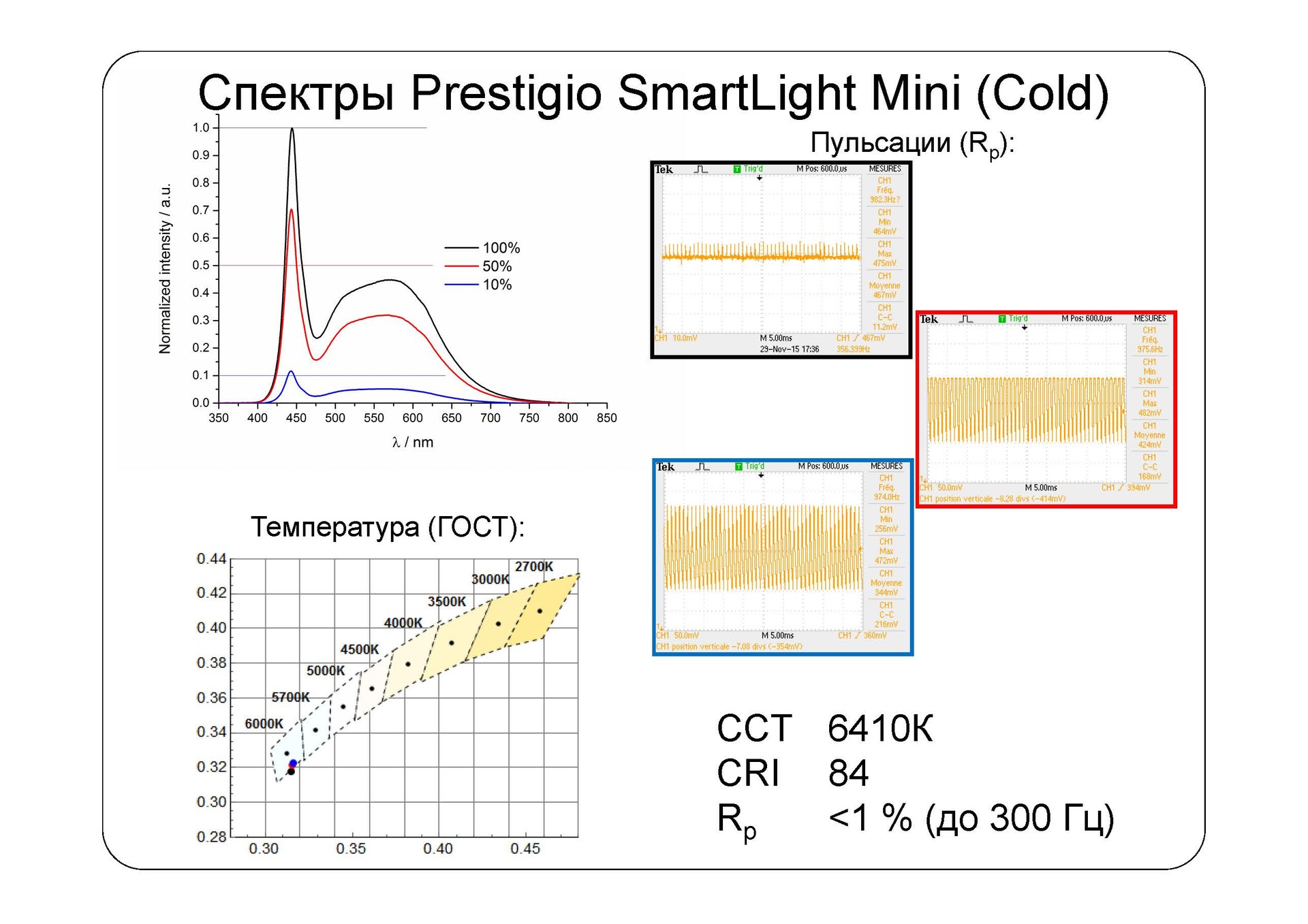
The color of the ripple frame of the light flux corresponds to the intensity of 10, 50 or 100%
Lamps have a ripple rate of less than 1% at frequencies below 300 Hz, which, as we now know , are governed by GOST. However, when dimming the lamps begin to “buzz” (no, not in terms of sound!), But in terms of light intensity, with a frequency of about 1 KHz, similar beats of the light flux were seen on Gauss lamps even without dimming .
Lyrical digression: I had to make sacrifices for the sake of science and answer the question posed in the Gauss lamp article: do such high frequencies affect perception and general well-being?
I answer: I put 3 SmartLight Mini lamps in the living room at 50% power, for 5 months no side effects were noticed.
As we can see, the color temperature for the coldest light was as much as 6410K with a color rendering index of about 84. At the same time, the average mode gives about 4200K with CRI 86, but the warm mode - 3200K with CRI 83.
NB: Note that the color temperature was set by a slider, so some flaws may well be present.
The color of the ripple frame of the light flux corresponds to the intensity of 10, 50 or 100%
The color of the ripple frame of the light flux corresponds to the intensity of 10, 50 or 100%
The bulb in the E14 base is rated for 5 W, which according to LampTest should correspond to about 60 W in terms of the Ilyich light bulb. Also, an adapter from E14 to E27 has been added to the kit for the convenience of users.
The graph below shows the spectra of each of the "color" channels separately. Only for clarity, below is a color scale. Yes, the wheel-slider in the application, perhaps, is not the most convenient control tool, but it seems that they managed to achieve “pure” colors: red, green and blue. Soon we will try to do several types of color management, including through direct input of hex-coding.
As mentioned above, the application has a Light Organ function, so the author podzazhal E14 lamp for the disco evening in the living room. Instead of this lamp on the knife, we put the lamp E27.
SmartLight E27 (9 W): Maximum Lighting Capabilities
In addition, a more powerful light bulb will be more interesting to dig. She, the lamp, is designed for 9 W, which should roughly correspond to a 100 W Illich lamp.
SmartLight 9W box reversal
Briefly, in a couple of phrases and three pictures let us dwell on the spectral characteristics. In this aspect, the older brother behaves similarly to the younger one, only there will be more LEDs. In general, good performance in color temperature: from 3030K to 6290 K with a CRI of 81 to 85. When dimming, the luminous flux pulsates at frequencies of about 1 KHz, but these are design features, including the driver.
In all the pictures presented, the color of the ripple frame of the light flux corresponds to an intensity of 10, 50 or 100%
Under the diffuser of light, as is the case with the younger fellow, there is an aluminum plate with LEDs and a BT-module, which is connected with a huge radiator through thermal paste and a pair of bolts. The radiator itself weighs 158g ( ! ) With a total lamp mass of 215 g. Thermal grease is evenly distributed and covers the entire area of the substrate - made to last - which provides excellent contact and thermal conductivity, as well as efficient heat dissipation.
The transparent diodes are RGB LED assemblies, the yellow and orange diodes are responsible for the “warmth” and “cold” of the outgoing light. In the center we can see a BT-module with a copper wire antenna.
Inside is the same BT-module based on the CC2250 chip from TI. The driver is a full-fledged flyback converter with galvanic decoupling ( pay attention not to cut in the middle of the board ). The control board is LNK 606GG from Power Integration ( data sheet and ref.design ). In general, all the structural elements of quality and made at the proper level.
Refer to the LEDs themselves. A total of 36 SMD LEDs are installed on the board, which are responsible for white light: 18 for warm (orange) and 18 for cold color temperature. Plus, additionally installed 9 RGB LED assemblies (white with transparent fill). They are responsible for changing the color of the light bulb and the Light Organ function.
In the transparent case there are three LEDs of separately red, green and blue colors. Blue and green LED are similar to each other, their size is nearly 200 microns (195 to 195 microns). But red is very different from them: not only is it somewhat smaller in size (145 to 145 microns) and it has a funny shape of the upper electrode, as well as it is covered with a bright red textured layer of dye.
The light-emitting diodes in the bulb for “warmth” and “cold” of the light emitted are not easy to distinguish in terms of the composition of the phosphor, but they are also made on two different substrates ( “shield” and “star” textures ). Although, on the other hand, the size of the LED chip in them is identical and is approximately 270 per 130 μm, we have already seen similar ones when analyzing Gauss lamps .
In conclusion, let's say, more precisely, we will repeat a few words about the temperature and explain why we need such a large radiator. We will compare with the IKEA Ledare 400 lm lamp with half the power (nominally Prestigio gives 800 lm).
In the process of work of different modules, heat is generated, mainly from the LEDs themselves, but do not forget that there is a BT module on the board. With intensive use of the latter (Light Organ, for example), it will also make a significant contribution. It is for the dissipation of this heat into the surrounding space that a large radiator is needed.
The figures for the measured surface temperature of the radiators speak for themselves. The IKEA lamp body warms up to 75 degrees for half an hour, with more SmartLight Prestigio power — only up to 58. And the maximum temperature of the SMD LEDs of Prestigio lamps at maximum power was about 60-70 degrees, which is absolutely safe for LEDs. Therefore Prestigio lamps will delight you as long as possible (well, do not forget about the two-year warranty)!
Subjective view
At the moment, five lamps are being tested in the house (three E14 in the living room and two E27 in the bedroom), which were installed not in any special chandeliers, but in the most ordinary ones - from IKEA.
According to subjective feelings, three E14 lamps, perhaps not enough for a living room. Especially if the exercise requires fine motor skills, for example, modeling ( 1 , 2 ). But then, when comrades arrive, you can please them with color music and have a small party!
The living room has a Philips LivingColors Aura White lamp with a remote control for changing color, intensity and saturation. Despite a lot of advantages, and it has some drawbacks compared with Prestigio lamps. Among those, for example:
- no on / off timer;
- Only two presets, that is, only two buttons to quickly move from one color / intensity to another;
- A separate outlet for installing and connecting electricity is required, plus a rather voluminous power supply unit;
- too bright directional flow, so you have to invent something (direct light from the cabinet to the ceiling) in order to get a more uniform illumination of the room.
At the time of purchase of the lamp from Phillips, its price was equal to the cost of 2 Prestigio SmartLight 9W lamps.
findings
- Prestigio SmartLight lamps in general give the impression of a high-quality product. Especially when you independently look under the
skirtbase: thoughtful design and selection of quality components. - By tradition, the test data is summarized in the table below. Of course, there is a small fly in the ointment. The SmartLight Mini light bulb did not reach the stated minimum color temperature of 3000K, about 200 degrees. Perhaps because of the wheel in the application itself Prestigio Smart Home. Soon, an update should be released, which will fix it by adding several control modes to choose from.
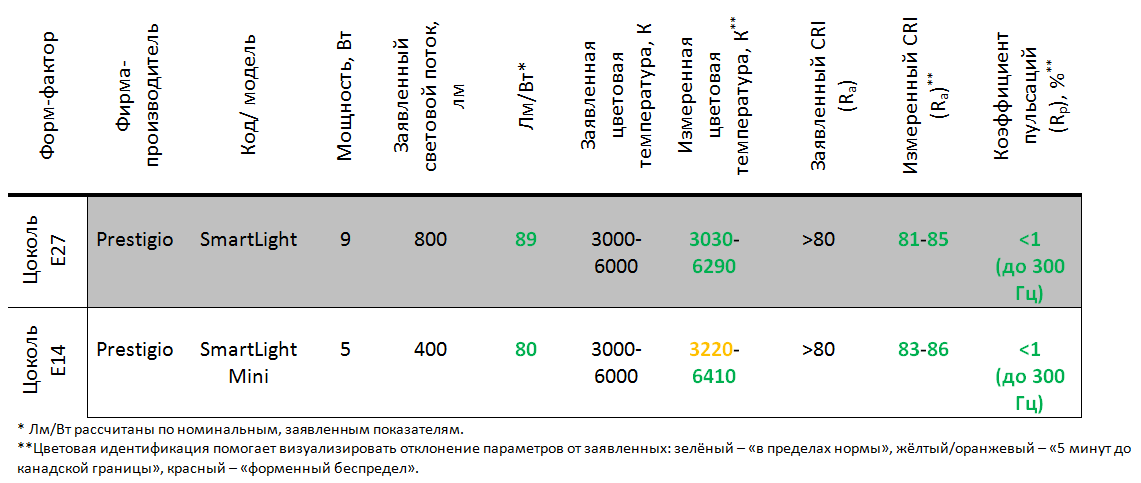
Someone will say that the characteristics of LEDs are not the most impressive (for example, the efficiency is below 100 lm / W, CRI 80-85, not 90). But in the tested lamps, the bet is made precisely on the reliability and stability of work over a very long period of time. - Light bulbs are connected via the BlueTooth channel and receive a signal from a smartphone at a distance of up to 15 meters. At home, the lamps in one room can be safely controlled while being physically in another room.
- And of course, the cool feature of these lamps is Light Organ, which will turn a meeting of friends at home into a disco with light-music, and make a romantic dinner unforgettable!
You can also connect a smart weather station , which we will talk about next time, to a smartphone running Prestigio Smart Home. We will measure the surrounding weather conditions!
Have a nice day surrounded by smart things and people!
Do not forget to subscribe to our blog : you are not difficult - we are pleased!
PS: In the comments was raised the theme of the light alarm. As such, the built-in function of the "light alarm" in the Smart Home application is not, but you can customize the light and even color alarm clock yourself. For the demonstration, we have prepared a short video on how it works:
A full list of published articles "Inside look" on Habré and GT:
Opening the Nvidia 8600M GT chip , a more detailed article is given here: Modern chips - a view from the inside
An inside look: CD and HDD
An inside look: LED bulbs
An inside look: the LED industry in Russia
An inside look: Flash and RAM
An inside view: the world around us
Inside View: LCD and E-Ink Displays
An inside look: matrix digital cameras
An inside look: Plastic Logic
An inside look: RFID and other tags
An inside look: postgraduate study at EPFL. Part 1
An inside look: postgraduate study at EPFL. Part 2
An inside view: the world around us - 2
An inside view: the world around us - 3
View from the inside: the world around us - 4
An inside look: 13 LED lamps and a bottle of rum. Part 1
An inside look: 13 LED lamps and a bottle of rum. Part 2
An inside look: 13 LED lamps and a bottle of rum. Part 3
An inside look: IKEA LED strikes back
An inside view: are Filament lamps good for you?
An inside look: smart lights SmartLight
and 3DNews:
Microview: a comparison of modern smartphones displays
Source: https://habr.com/ru/post/391065/
All Articles
